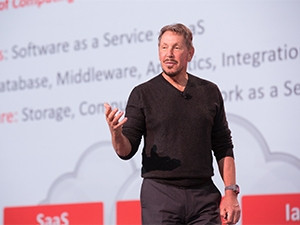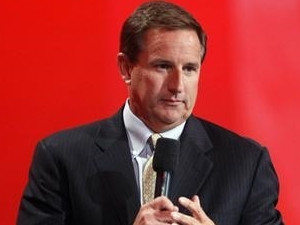
On stage at Oracle OpenWorld this year, Oracle founder Larry Ellison and CEO Mark Hurd made a series of key predictions about the cloud computing industry. Among them were these: within 10 years, 80% of enterprise applications will be deployed in the cloud, and 80% will be delivered by two vendors. (The execs clearly wanted the audience to identify Oracle as one of the two!)
It sounded, at first, like hyperbole. Exaggerated marketing fluff to justify Oracle's astonishing 180-degree U-turn on the cloud, from dismissing it as a fad a few years ago, where it is now: the wall-to-wall rebranding of the gigantic OpenWorld event as a cloud event is the culmination of an enormous (and enormously costly) effort to re-engineer its entire product line. Everything is either in the cloud, or railroading there as fast as the firm can manage.
There's almost a sense of desperation in the air. The company has adopted an "all things to all men" strategy: all its products have been extensively rewritten for cloud deployment, and its portfolio of hardware, software, hosting and services has been retooled for the cloud and augmented by acquisitions and new products as the market develops. The sudden popularity of Docker containers, for example, had Oracle (and Microsoft and VMware and many others, for that matter) scrambling to build out compatible frameworks.
That's not really indicative of a focused strategy; it smacks more of "do everything, we'll figure out what's working later". That buys time, sure, and trades the risk of backing the wrong horse against the enormous expense of taking the entire business on the same journey at the same time.
So, today, Oracle has gone from having very little meaningful footprint in the cloud a few years ago, to an umbrella portfolio which touches almost every flavour of cloud service imaginable. The entire software suite has undergone rework for the cloud. The firm runs its own public cloud, which again runs its own software as well as its own hardware to offer bare-metal infrastructure-as-a-service, and, well, basically everything in between. If you drop the word "cloud" into a conversation, someone from Oracle will probably interject with "we can do that".
Not only is Oracle's cloud portfolio sprawlingly enormous, it's also starting to compete aggressively on price. Apparently stung by the reality that a lot of cloud deployment really is driven by price, Ellison declared Oracle's cloud archival storage will be cheaper than Amazon's. If they lower their prices, we'll lower ours, was the promise. Such dogged determination to win the race to the bottom is noteworthy, but whether it can translate into profit remains to be seen. Today storage is cheap, maybe it'll be processor cycles tomorrow and, who knows, maybe ERP applications next year.
Show me the money

Profit is the big question here. Oracle, like many of its competitors, is proud of its strong growth in the cloud, but triple-digit growth off a low base can translate into fairly small potatoes. Right now, analysts peg the only company with real money potential in the cloud as Amazon, with its multi-year head start, enormous user traction, and an ongoing investment in infrastructure which dwarfs the rest of the market.
What makes matters murkier is how cloud customers and revenue are measured. A lot of the cloud success stories that vendors hold up, still operate data centres of their own and still run a broad suite of traditional in-house enterprise applications (Oracle: "we can do that!"). What's more, many of them acquire cloud products from multiple sources, and as the friction of migration continues to erode, more and more of those success stories are not about migration of incumbent applications into the cloud, it's about winning business from other cloud companies.
What this means for vendors like Oracle is that their revenue is becoming increasingly fluid ? based on consumption rather than licensing, and with less stability and loyalty momentum.
So let's come back to Ellison's predictions, and why they matter so much. Let's assume, for the sake of argument, that he genuinely believes them and has based a business strategy around them ? analyst firms back them up to varying degrees.
First of all, most enterprise applications certainly will be in the cloud. That's almost a given, the same way most enterprise applications today are virtualised. There are questions around whether the cloud in question will be private or public, but that's largely semantic ? the point is, you won't be deploying applications the same way. If you are (or if your supplier is), then you'll probably be paying a hefty premium for legacy inefficiency. The movement towards "provision only what you need, and buy only what you use" is probably unstoppable.
Survival of the fittest ? but fit for what?
The point, though, is that those enterprise applications themselves may become fundamentally different, and that is probably the part which is keeping Ellison and his joint CEOs Safra Catz and Mark Hurd awake at night.
That second prediction, that 80% of applications will be sourced from two vendors, is a huge leap of faith. Today, we're in a transitionary period where while it's possible to provision multiple different enterprise applications and stitch them together through APIs and middleware, it actually just doesn't work very well at scale. You can deploy SalesForce and WorkDay and SharePoint and Sage and Slack and a hundred other separate components, but the reality is that doing so greatly increases integration difficulty and risk. Right now, large firms tend to stick with (or come back to) monolithic ERP stacks because it turns out the integration and support really does matter.
But that's today. Once upon a time, SalesForce was an SME CRM offering that no one in the enterprise space took seriously. How the tables have turned ? you have only to look at the number of times Ellison dissed SalesForce on stage at OpenWorld to understand how seriously he's taking the competition now. And while the Oracle stack has an undeniable advantage at scale today, it may not tomorrow ? the barriers are just that: obstacles that cloud engineers exist to overcome.
And this is why Oracle's en masse retooling of its products is significant: the company is preparing for two equally important futures. In one, heterogeneous cloud software stacks are finally able to deliver equal benefit to large customers, the ERP monolith topples, and Oracle has to compete both as a stack against the world, and as a minority player in someone else's stack. In the other, small and mid-sized businesses, frequently born in the cloud and with very different expectations of how software should be delivered and priced, consume small, bespoke components which individually offer miserable margins but scale to profit through hyperscale orchestration. Either way, it wants to be one of the dominant suppliers of whatever it is anyone is buying in the cloud.
10-year prediction, not a 10-year plan
This is not a 10-year plan, for all Ellison's predictions. It's a this-year plan: the disruption is already under way, and the fundamental question is how fast it will play out.
There is still the question of what the next generation of enterprise applications will look like. The rapid rise of containerisation shook the established virtualisation market, but to be realistic it is still far from unseating it. NoSQL databases have certainly proved their worth, but aren't going to displace the enormous existing relational database market any time soon. Can a whole new paradigm of enterprise application disrupt not just existing ERP vendors, but existing ERP thinking? It's not impossible.
Oracle is hedging against multiple permutations of that, by expanding its portfolio and configuring itself for agility and rapid response; acquiring new technologies and moving reflexively to answer new customer demands. That's an expensive game of Whack-a-Mole, though, and Oracle may have to adopt a more aggressive position on culling underperforming lines of business, something it is historically unwilling to do. "Long-term support" has a very different meaning in the ERP space, but there's the evolution question right there: do large enterprises want suppliers that support every module for decades, and roll the price for that support into their licensing, or suppliers that enable easy migration away from components so the risk of end-of-life is minimised?
That was a trick question, of course, because easy migration and ERP are not phrases you often hear in the same sentence. The fact that it's even on the agenda now shows just how seriously Oracle is taking Larry Ellison's predictions of evolution.
Lastly, the real kicker is this: Ellison, Catz and Hurd are not spending billions on high-risk cloud transitions for fun. They're doing it because they believe that failure to do so will cost them business. In other words, they realised their customers are evolving away from them, and they must evolve too. You could replace "Oracle" with "Microsoft", "IBM" or several others in the same context ? similar discussions are happening in every software house, and each of them is relying heavily on a small set of keystone advantages to support what may become crucial survival strategies.
As a customer, you should be asking yourself the same question. Are you evolving? Do you have a roadmap? It's not about pushing stuff into the cloud ? that's just hiding your legacy overheads in someone else's fridge. It's about fundamental re-architecting of not just your IT, but also business processes and people. If you aren't doing that, the brutal reality is that the industry leaders you're buying from today ? Ellison, Nadella, Rometti, Bezos ? don't think you'll be around as a customer for much longer.
Share